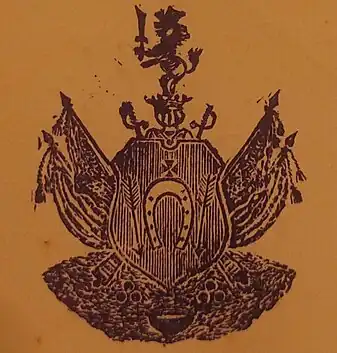Łada coat of arms
Łada (Łady, Ładzic, Mancz)[2] is a Polish szlachta coat of arms originating from Mazovia.
| Łada | |
|---|---|
 | |
| Details | |
| Alternative names | Łady, Ładzic, Mancz |
| Earliest mention | 1464–1480 |
| Families | 210 names[1] Bardowski, Bartosiewicz, Bartoszewicz, Bartoszowicz, Bączkowski, Bieniakoński, Bieniaszewski, Bieńkowski, Bogdanowicz, Bogdanowski, Bohdanowicz, Bohdanowski, Bondzinski, Bordowski, Borzymowski, Broda, Brodowicki, Brodowski, Broszkowski, Bródka, Brudnicki. Chodakowski, Chojnowski, Ciszkiewicz, Ciszko, Ciszkowicz, Cybulski, Cyrus-Sobolewski, Czaprański, Czarnowski, Czerniachowski, Czerniak, Czerniakowski, Czernichowski, Czerniechowski. Dąbrowa, Dobkowski, Dobryszewski, Dobryszowski, Dobrzyniecki, Dobrzyszewski, Dogel, Dogiel, Dzierżanowski. Falk-Regulski. Gierałtowski, Gierkowski, Glatowski, Gnatowski, Goreczkowski, Góreczkowski, Grabowski, Gradecki, Gramnicki, Grącki, Grądzki, Grodecki, Grodzicki, Grodzki, Gromnicki, Groński. Herman. Jacek, Janikowski, Jankowski, Janowicz, Januszewicz, Januszewski, Januszowski, Jasiński. Kamiński, Kapuszczewski, Kęski, Kiłdjarowicz, Kitajgrodzki, Klimowicz, Kłodnicki, Kłodzieński, Kłodziński, Kobyliński, Kokoszczyc, Kokoszka, Konstański, Kopański, Koronowski, Korziuk, Kotowski, Kowalewski, Krassowski, Krczytowski, Kroczowski, Kruszewski, Kucz, Kuczewski, Kulicki, Kurnatowski, Kustrzycki. Ladowicki, Lipski, Lutosławski. Łachański, Łaciński, Łada, Ładomirski, Ładowicki, Ładowski, Ładzic, Ładzicki, Łapa, Łapiński, Łappa, Łappo, Łaszkiewicz, Łatko, Łazomski, Łazowski, Łobaczewski, Łobaszewski, Łopata, Łopatko, Łukasiewicz Mandecki, Mazarski, Michałowski, Milanowski, Młosoł, Młosoła, Mocarski, Moczarski, Moczulski, Możarowski, Mrocki, Mussoła, Musuła. Noskowski. Omorowski, Otocki. Pieskiewicz, Pieszkiewicz, Pieszkowski, Pilch, Pilchowski, Pomorski, Proszkowski, Prószyński, Pruszkowski, Przezdziecki. Radostowski, Rechej, Regulski, Remberowicz, Rembertowski, Rembiertowski, Rendzina, Rendziński, Rędzina, Rędziński, Rozbicki, Rożniszewski, Rybowski, Rzędziński. Sandrowicz, Scenia, Siderkiewicz, Skrzyński, Skupski, Służowiecki, Smarzyński, Smerczyński, Smereczyński, Smerżyński, Sobolewski, Sucharzewski, Suliński, Szopa vel Rędzina, Szuniewicz. Świdlicki, Świetlicki. Tabański, Tabeński, Trąbski, Trąmbski, Tyborowski, Tyszecki. Walicki, Wąsowicz, Wąsowski, Wład, Wojchowski, Wojciechowski, Wysocki. Zabłocki, Zaleski, Zaleszczyński, Zalewski, Zamuszkiewicz, Zaorski, Zarciszewski, Zawadzki, Zawistowski, Zawiszowski, Zborzyński, Zgorzelski, Zwoliński (also: Zwolański, Zwoleński)
|
History
The earliest mention of the coat of arms comes from court records from 1401.[2] The earliest attestation of the seal appears in 1466 in the document of the Peace of Toruń.
The earliest heraldic source mentioning the Łada coat of arms is Insignia seu clenodia Regis et Regni Poloniae historian Jan Długosz, dated 1464-1480. He records information about the coat of arms among the 71 oldest Polish noble coats of arms in the passage: "Lada, que ex domo Accipitrum deriuationem sumpsit, deferens babatum cruce signatum et in uno cornu sagittam, in altero retortam, in campo rubeo. Lada a nomine dee Polonice, que in Mazouia in loco et in villa Lada colebatur, vocabulum sumpsit exinde.". According to Długosz it derives from Jastrzębiec family and derived the name from an alleged Polish goddess Łada worshipped in the village of Łada in Mazovia.[2]
Blazon
According to Długosz: red, a horseshoe argent, silver horseshoe pointing downwards, surmounted of a golden cross pattée; on the right, a silver arrow in a pale, on the left, an arrow with a pall pointing downwards; in the crest, a golden half-leaf in a crown with a sword in its right paw.[3]
However, the Herbarz Arsenalski (c. 1535-1555) describes the coat of arms as red, a horseshoe with the caulkins pointing upwards, a cross pattée in the center, and the letters A and V above the caulkins.[2]

According to the Herby Rycerztwa Polskiego (1584), the background was blue and the arrows were pointing upwards (III).[4]

The version with hunting horns under the horseshoe (IV) does not appear until the 18th century on the initiative of the illustrator of Korona polska by Kasper Niesiecki, who probably used block from earlier books on coats of arms to illustrate the Łada, reworking them in various ways.[5]

Although the coat of arms found in Bondzinski family nobleship documents is uncoloured, it is clearly seen that the arrows are pointing downwards, they are both identical, the knight has two swords - one on the left and one on the right. Also below the shield there is ground with bottles and plums or apples, this could indicate that Bondzinski family were brewing alcoholic beverages. From the sides of the shield there are four flags on spears. The coat of arms has a lot of weaponry - this could state that the roots of the clan were martial. The documents were signed in 1905 by the government of Russian Empire ruled by the Tsar Nikolai II.
References
- Gajl 2007.
- Kamocki 1925, p. 11.
- Niesiecki 2005, p. 201-202.
- Kamocki 1925, p. 15.
- Kamocki 1925, p. 21.
Bibliography
- Kamocki, Franciszek (1925). Geneza dwu godeł w herbie Łada (in Polish). Warszawa.
{{cite book}}: CS1 maint: location missing publisher (link) - Niesiecki, Kasper (2005). "Łada". In Marek, Minakowski; Boniecki, Adam (eds.). Herbarz Polski (in Polish). Vol. 6. Kraków. ISBN 83-918058-3-2.
{{cite book}}: CS1 maint: location missing publisher (link) - Gajl, Tadeusz (2007). Herbarz Polski (in Polish). Gdańsk.
{{cite book}}: CS1 maint: location missing publisher (link)

